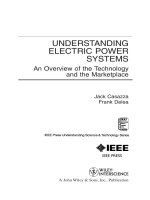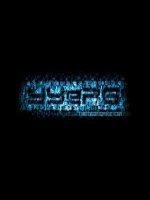Advanced network solutions for electric power applications
Bạn đang xem bản rút gọn của tài liệu. Xem và tải ngay bản đầy đủ của tài liệu tại đây (2.75 MB, 40 trang )
Slide 1
1
Advanced Network Solutions for
Electric Power Applications
George Wang
Presentation for IEEE Student Branch
Slide 2
Introduction and Background
•
Electric power is essential to our life and the
economy
•
Power systems are getting more and more
sophisticated and smarter
•
Teleprotection plays a key role
•
Telecommunication and network technology
have changed our life
•
Communication network is more and more
important for electric power
•
Next big wave
Slide 3
3
Generation
Distribution
Transmission Grid: 110 kV up
Distribution Grid: 50 kV down
Transmission
Slide 4
4
Generation DistributionTransmission
Basin Electric
Tri-State Electric
Rushmore Electric
Central Iowa Power
Brazos Electric
Chugach Electric
CenterPoint Energy
Knoxville Utilities
INDE (Guatemala)
INDE (Institute of National Electrification): the largest electric generation and
transmission company owned by Guatemala government.
To build an advanced communication network
A big substation
Slide 6
6
Communication in Substations
•
Need channel banks for voice (phones) and data
•
Need mux to connect to a radio
•
Dry contact for house keeping alarms
•
Data Bridge for the subrate data
•
Some customers still interested in OCU-DP card
•
LV/LV+ used as configuration tools
•
Ethernet for service computer access
•
RS232 for RTU
•
-125VDC power
•
One box does all
Substation hardened. IEC 61850-3 / IEEE 1613
Slide 7
ANSI Standard Device Numbers
(IEEE Standard C37.2)
1 - Master Element
2 - Time Delay Starting or Closing Relay
3 - Checking or Interlocking Relay
4 - Master Contactor
5 - Stopping Device
6 - Starting Circuit Breaker
7 - Rate of Change Relay
8 - Control Power Disconnecting Device
9 - Reversing Device
10 - Unit Sequence Switch
11 - Multifunction device.
12 - Overspeed Device
13 - Synchronous-speed Device
14 - Underspeed Device
15 - Speed - or Frequency, Matching Device
16 - Data Communications Device
17 - Shunting or Discharge Switch
18 - Accelerating or Decelerating Device
19 - Starting to Running Transition Contactor
20 - Electrically Operated Valve
21 - Impedance (21G implies ground impedance)
24 - Volts/Hz
Device numbers are used to identify the functions of devices shown on a
schematic diagram. Function descriptions are given in the standard. These
types of devices protect electrical systems and components from damage
when an unwanted event occurs, such as an electrical fault.
27 - Under Voltage (27LL = line to line, 27LN = line to
neutral/ground)
40 - Loss of Excitation (generator)
47 - Negative sequence voltage
50 - Instantaneous overcurrent (N for neutral, G for
ground current)
51 - Inverse Time overcurrent (N for neutral, G from
ground current)
59 - Over Voltage (59LL = line to line, 59LN = line to
neutral/ground)
62 - Timer
64 - Ground Fault (64F = Field Ground, 64G = Generator
Ground)
79 - Auto-reclosure
81 - Under/Over Frequency
86 - Lockout Relay / Trip Circuit Supervision
87 - Current Differential (87L=transmission line diff;
87T=transformer diff; 87G=generator diff)
91 - Voltage Directional Relay
92 - Voltage and Power Directional Relay
93 - Field Changing Contactor
94 - Tripping or Trip-Free Relay
Slide 8
Suffixes and Prefixes
“N” suffix: Neutral wire. 59N in a relay is used for protection against
Neutral Displacement
"G" suffix: "ground", hence a "51G" is a time overcurrent ground relay
“S” for Serial
“E” for Ethernet.
“C” for Security Processing Function {i.e. VPN, Encryption}
“F” for Firewall or message Filter
“M” for Network Managed Function
“R” for Router
“S” for Switch
“T” for Telephone Component.
Thus “16ESM” is a managed Ethernet.
A suffix letter or number may be used with the device number
Slide 9
Power Quality and Protective Relays
Power quality can be defined by four fundamental
parameters: Frequency, Amplitude, Shape, and Symmetry
Power quality is affected by a wide range of disturbances
throughout the transmission and distribution network.
It is necessary to implement various measures in order to
minimize the negative effects on customers.
Depending on which of the power quality parameters is
distorted the influence on the performance of digital
protection relays will be different.
Slide 10
Protection Relaying over All
Communication Media (ABB)
Slide 11
11
Telecom Networks: PDH, SDH, and Ethernet
STM-16 (OC-48) Ring
O9340S
E3/T3/E1/T1
Gb Ethernet
STM-1/4 (OC-3/12)
STM-4/1 (OC-12/3) Ring
Loop-iNMS
O9500
E3/T3/E1/T1
Gb Ethernet
Bonded
G.SHDSL.bis
O9400S
E3/T3
H3308S
Ethernet
Backbone
G
b
E
O9400R
T
D
M
o
E
{H3304R / H3308R / O9340R}
E
t
h
e
r
n
e
t
AM3440
O9400R
O9400R
O9400R
O9400R
O9500
V4100
G
b
E
/
E
t
h
e
r
n
e
t
/
E
1
C5600
Proprietary GbE
GbE
E1/T1
2G BTS
3G/3.5G Node B
E1/T1/DTE
GbE/Ethernet/G.SHDSL
FOM/E&M/FXS/FXO
C37.94/DryContact
E1/T1
E3/T3
E1/T1
G.SHDSL
E1/T1/DTE
Ethernet
G.SHDSL
FOM/E&M
FXS/FXO
W8140
(or Radio)
W8140
(or Radio)
WiFi or
µ
wave
Ethernet
FOM SPRing
AM3440
AM3440
E1/T1/DTE/G.SHDSL
FOM/E&M/FXS/FXO
C37.94/DryContact
Ethernet
IP6700
E1/T1/E3/T3
Ethernet
E1
E1 SPRing /
E1 DS0 SNCP
AM3440
E1
E1
E1
AM3440
E
1
STM-1 (OC-3)
Ethernet RSTP
/ LEAPS Ring
FOM
IP6810
RS232/RS485/Ethernet/DryContact
IP6810
RTU
IP Camera
Slide 12
12
Electric Power Industry Application:
Data and Voice Communications
RTU
Host
Security
Server
SONET/SDH Network
PBX
Management Center
FXS
RTU
RS232
10/100Base-T
Security Terminal
V.35
T1/E1
RTU
RS232
10/100Base-T
Security Terminal
V.35
T1/E1
Remote
Sub-station
B
AM3440
V4200-9
PSTN
Data-Base
Server
Remote
Sub-station
A
T1/E1
FXO
V.35
RS232
10/100 Base-T
LoopView
FXS
AM3440
SCADA
Controller
E&M
Modem
E&M
Intelligent
Transmission &
Distribution
Slide 13
13
DCS-MUX Product Example
Substation hardened. IEC 61850-3 / IEEE 1613
Slide 14
14
Interface Cards
Substation hardened. IEC 61850-3 / IEEE 1613
Slide 15
15
Loop O9400R (SDH/SONET)
O9400R STM-1/4/16 (OC-3/12/48) ADM
Slide 16
16
Dry Contact: Network Application
Slide 17
17
Telecom Room
Slide 18
18
Slide 19
19
DS0 SNCP Protection
Slide 20
20
T1 Radio: 1 for 1 protection
Network
Leased line
Provider
T1 Radio
T1
T1
T1
T1
T1 T1
AM3440:
T1 1 for 1
protection
AM3440:
T1 1 for 1
protection
Note:
1. “Network” and “Leased line” shall support Alarm forwarding.
2. The switching time of T1 1 for 1 protection at AM3440: < 50ms
Slide 21
21
Network Management System
(NMS)
Loop-iNMS:
•
iNMS core
•
Device Poller
•
iNMS GUI Clients
Capability:
•
Full FCAPS
•
System Redundant
•
System Protection
Slide 22
22
Disaster Recovery (DR)
DR (Disaster Recovery)
Slide 23
23
Alarm Monitoring View
Alarm View on
Network Topology
Active
Alarm List
FCAPS - Fault Management
Slide 24
24
View – NE Panel View
Basic Feature - View
Slide 25
25
Power Application-1
(Swiss Project)
Case Study









